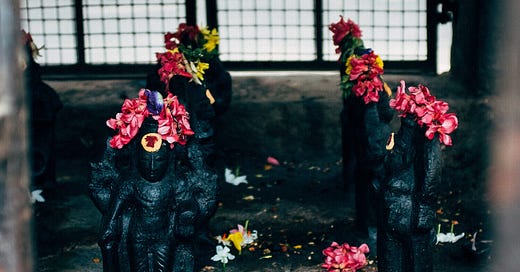If you missed part I of these explorations, you can find it here.
If you find Seeds from the World Tree worth your while, please consider upgrading to a paid subscription. Having a solid sustainer base makes all the difference when it comes to putting my best into this project over the long term. Thanks so much to all who have contributed already.
Jyotish, India’s astrological wisdom tradition, can be understood as an elaboration of the law of karma. Jyotish sheds light on the what, when, how, and for god’s sake how much longer?
If you’re wondering what the planets have to do with karma, the answer (from a Vedic perspective) is ‘a lot.’ In a mysterious but weirdly precise way, the planets are charged with delivering the karmic “fruit” that’s due to ripen in a given time period. They do so in accordance with their individual natures.

Venus brings us largely pleasurable, luxurious, juicy and erotic experiences.
Mars brings heated, conflictual ones as a rule.
The nodes (Rahu and Ketu, as they’re known in Sanskrit) bring flavors of the unusual, bizarre, off-kilter or beyond-the-pale.
Each planet delivers its results not generically, but in accordance with its exact position, condition and combinations at the time of birth.1
Now, before we get further into the nitty-gritty, it’s worth stepping back for a moment and asking: is it a coincidence that the horoscope reflects the life of the native?
A skeptic might argue that the meaning-making mind will find patterns in anything and apply them retroactively, then say ‘aha! But it’s apparent to anyone who’s spent time learning astrology and studying charts that there is something more interesting going on than a Rorschach test (interesting as those, too, can be). The fit between chart and native is too close to be ‘mere’ coincidence. Rather, each soul seems to join the human fray at a moment exactly appropriate for and reflective of its mission, burdens and agreements.
As for how this soul agreement / karmic bundle stuff get hashed out before birth, well, that question is well above my pay-grade. But I can’t help but wonder.
Do we get to decide before jumping into a womb-room what combination of accumulated karmic seeds will be ripening that lifetime? Do we get any say at all (beyond what we’ve already exercised in planting the karmic seeds in the first place)? I suspect it’s generally not for us to know such intricacies while we’re in these meat suits. As Tom Waits quipped when someone whipped out their phone to fact check something or other, “let’s just wonder a while.”
But it’s such an elegant set-up, the way that the macrocosm and microcosm align at the moment of birth, that one starts to feel it couldn’t be otherwise.
In any case—returning to our main thread—Jyotish allows us to get a sense of the size and shape of a particular piece of karma, including how firm or fixed (drdha) it is. This is helpful as a first step in forming a strategy for how to work with whatever it is.
To perform this analysis, we study the horoscope for its degree of confluence around a given theme. In a nutshell, the more different ways a chart is telling us a thing, the more unshakeable the outcome.
Suppose a client is complaining of difficulties with his father. Let’s say the dad is ill and obstreperous. Stubbornly refusing help, yet unable to manage on his own. In denial of the straits in which he finds himself. Making more trouble for everyone the deeper he digs himself.
In such a case, matters would be considered quite intractable if three out of three relevant factors are under duress. That’s what’s meant by confluence.
We’re talking about the horoscope of the son or daughter who is worried about and struggling with the father, not the chart of the father himself. Of course one could also look at the father’s chart directly. impact ours. But if our karmic ruts and grooves are deep enough they’ll show up in the charts of those with whom are lives are interwoven.
In this case we would look at three factors to assess “father”: the 9th house of the horoscope, the lord of the 9th house, and the Sun.
If all of these three are compromised the daddy troubles are carved in stone. “Editing” them would take a Herculean effort and likely yield very limited results.
If only one out of the three shows problems, on the other hand, there is significant wiggle room, and the issues will be more amenable to resolution.
If two out of three, there may be some wiggle room, but less, with more effort required to finagle the wiggle. Of course this is an abstract and idealized example; any real case has to be scrutinized within the environment of the particular chart.
Karmic analysis through the chart is not limited to degree of intensity of a given piece of karma. One can also examine such matters as timing, relevant strengths and vulnerabilities, and so on. The idea is to give a well-rounded account that makes the adrsya (unseen) all but visible, something akin to an X-Ray or MRI for the soul.
The requires of the Jyotishi technical proficiency together with intuitive capacity—two wings working in tandem.
Now, here’s where things get juicy.
From all this karmic analysis—diagnostic in nature—prescriptive recommendations can and do follow. The whole process is analogous to medicine, or even, arguably, a form of it.
What kind of recommendations are we talking about here?
Keep reading with a 7-day free trial
Subscribe to Seeds from the World Tree to keep reading this post and get 7 days of free access to the full post archives.



